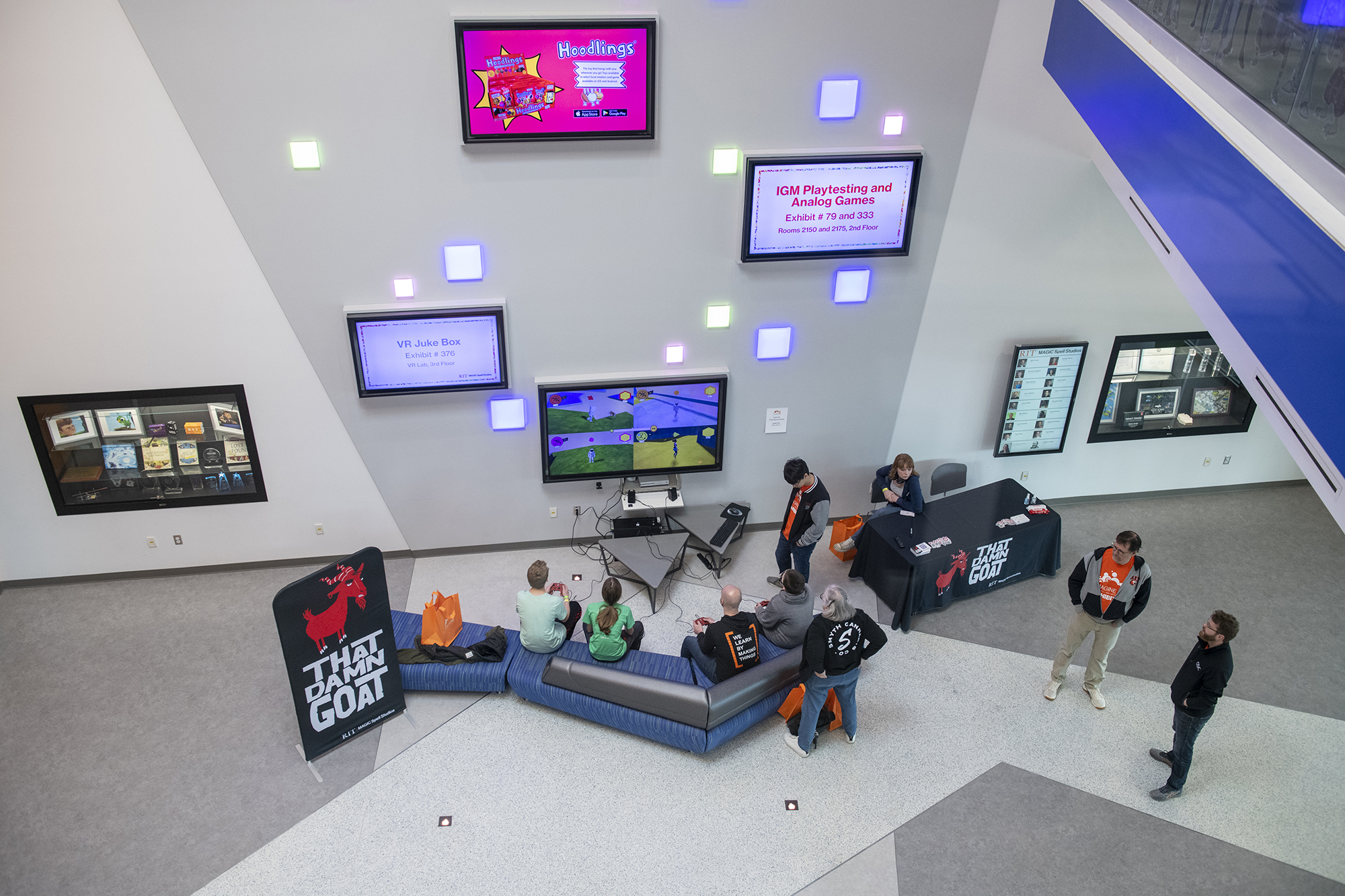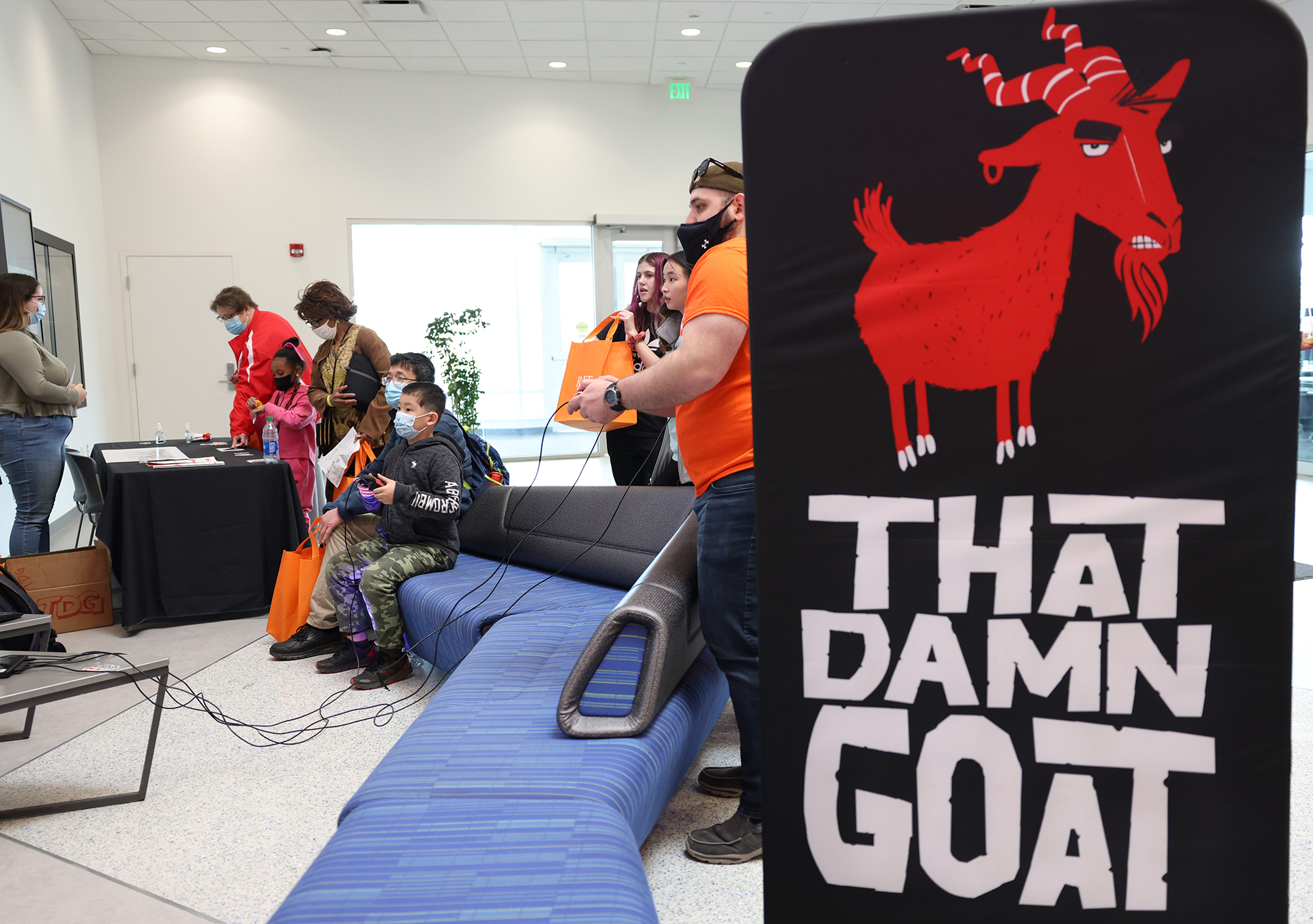Inside the making of 'That Damn Goat,' RIT's latest video game
Elizabeth Lamark
Visitors to the Imagine RIT festival had a chance to playtest "That Damn Goat" in 2022 and 2023.
Brian Larson is full of ideas. And he likes a challenge.
That convergence led to That Damn Goat, a large-scale game project produced in RIT’s MAGIC Spell Studios that was recently released for purchase on Steam.
Larson, associate professor and animation undergraduate program director, is the game’s creative director. He pitched the project with a creative vision and passion that shaded the fact he hadn’t made a game before.
“I have animated for TV and movies for decades. This was all new,” Larson said.
Larson, a 2D animator, welcomed the test of quickly advancing his skills in 3D computer graphics and digital sculpting software. He also coordinated countless other details involved in making a game.
“It forced me to learn something new because it was a whole production happening concurrently,” Larson said. “That was very exciting to me.”
To move That Damn Goat from concept to development, Larson enlisted the aid of Jesse O’Brien, assistant professor in the School of Film and Animation who has more than 15 years of game development experience. O’Brien is the game’s art director.
Jesse Wolfe '22
Imagine RIT visitors test out "That Damn Goat" gameplay in 2022.
In total, around 60 RIT students, faculty and staff from the College of Art and Design and Golisano College of Computing and Information Sciences had a hand in creating the game. They represented a variety of majors, including 3D digital design, film and animation (BFA), film and animation (MFA), game design and development, illustration, and new media design.
"Despite the fact that this was an academic project, we tried to run it as much as possible like an actual game production," O’Brien said.
“A lot of the students we hired got internship or co-op credit.” O’Briend added. “Even more importantly, companies want a shipped title on your resume as a prerequisite for almost any job. We were able to give students that experience before they graduated to get that line on their resume.”
That Damn Goat, spawned at the height of the Covid-19 pandemic, represented a hopeful return to a time where social distancing was an unfamiliar term.
“It’s a four-player, couch competitive game,” O’Brien said. “We really wanted it to be the anti-Covid game. This game is about hanging out with your friends, all in one place, sharing this experience together.”
'That Damn Goat' current and past faculty/staff leads
- Eric Baker (lecturer, School of Interactive Games and Media) and David Sanchez (visiting lecturer, School of Interactive Games and Media) - design leads
- Thomas Davis (adjunct faculty, College of Liberal Arts), Robert Mostyn (MAGIC digital games hub coordinator), and Stephen Yi (assistant professor, School of Interactive Games and Media) - audio leads
- Brian Larson (associate professor, School of Film and Animation) - creative director
- Hye-Jin Nae (associate professor, School of Design) - UI lead
- Aaron Nieboer (MAGIC production associate) - production lead
- Jesse O’Brien (assistant professor, School of Film and Animation) - art director
- John Veneron - (MAGIC production associate) - producer
- Austin Willoughby (senior lecturer, School of Interactive Games and Media) - development lead
The party game features environments in which characters battle for a crown while adjusting to constant chaos — such as the world or a player’s character changing — caused by a rogue goat.
“You have to adapt to the game instead of the game adapting to you,” Larson said. “Brian coined the term, ‘funstration.’ We wanted to experiment with the idea of the players having fun but always having a moment of tension in the gameplay.”
Hannah La ’22 (new media design), ’24 MS (human-computer interaction) worked for two years on That Damn Goat first as a concept artist and later as a user interface (UI) designer. She found the game’s work environment to be supportive and motivating.
“It was a great experience,” La said. “I saw the pipeline for concept art starting from the initial sketches of a character or environment and then going to the actual finishing product. It gave me a better sense of how that pans out in industry. It was a good place for me to grow as an artist and professional.”
After being releasing the game on Steam, the "That Damn Goat" team now has its sights set on a Nintendo Switch release. The game currently has four characters in addition to the goat.
Ian LaForest ’24 animation option (film and animation BFA) was given creative liberty in producing animations for the goat and other characters like the viking warrior. He said learning how to work with game engines allowed him to develop more marketable skills.
“With this job, I now have a better understanding of how that process works — animating in Maya and transferring to Unity,” LaForest said. “This gave me experience in those game engines.”
Right now, That Damn Goat has four worlds and four characters players can choose from (viking warrior, masked nomad, shaman and soccer mom), but the goal is to increase both to 12. The team is also working toward releasing the game on Nintendo Switch.
The game was produced using the unmatched digital resources available in MAGIC Spell Studios, a facility housing state-of-the-art animation labs and suites for sound mixing, color correction and other editing needs.
“One of the reasons MAGIC was created was to provide those things in house,” O’Brien said. “We got to use the whole breadth of the equipment and tools MAGIC has.”







